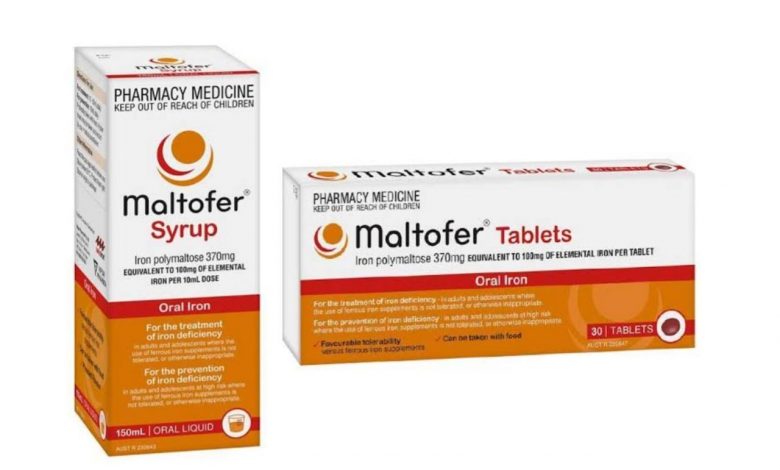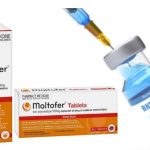Maltofer: Uses, Benefits, Dose, Side Effects, Interactions

What is Maltofer?
Maltofer is an over-the-counter oral iron supplement for the treatment of iron deficiency in adults and adolescents where the use of ferrous iron supplements is not tolerated or is otherwise inappropriate. Many people do not get enough iron from their diet, which can lead to low iron levels.
Men aged 19 and older require 8 milligrams of iron per day. Women aged 19 to 50 have a recommended intake of 18 milligrams per day; aged 51 and older need 8 milligrams per day. Pregnant women of all ages have recommended iron intake of 27 milligrams daily. For male and female adolescents aged 9 to 13 years, recommended amounts of iron are 8 milligrams daily.
Maltofer is clinically proven to correct iron levels. Maltofer has fewer gastrointestinal side effects and is less likely to cause constipation compared to ferrous iron supplements. This means less constipation, less nausea, and an effective dose of iron. It’s the kind of iron deficiency treatment many have been waiting for. Maltofer is manufactured in Switzerland and is available in more than 80 countries around the globe. In Australia, Maltofer is supplied by Vifor Pharma Pty Ltd. Melbourne VIC 3000.
What are the ingredients in Maltofer?
The active ingredients in Maltofer are as follows:
• Maltofer Iron Tablets: 100 mg iron as 370 mg iron polymaltose
• Maltofer Iron Syrup: 100 mg iron/10 mL as 370 mg iron polymaltose
Other ingredients Maltofer:
• Maltofer Iron Tablets: crospovidone, hydroxypropyl cellulose, hypromellose, iron oxide red, iron oxide yellow, macrogol 6000, magnesium stearate, cellulose – microcrystalline and titanium dioxide.
• Maltofer Iron Syrup: cream flavor, ethanol, methyl hydroxybenzoate, propyl hydroxybenzoate, water-purified, sodium hydroxide, sorbitol solution (70%) non-crystallizing, and sucrose.
Benefits
Maltofer contains iron(III) polymaltose complex which comes with several benefits that can include:
• High Bioavailability: Maltofer Iron(III) polymaltose complex has a high bioavailability, which means that a significant portion of the iron is absorbed and utilized by the body. This is because the iron in the complex is bound to a carbohydrate, maltose, which increases its solubility and stability. As a result, iron is released slowly in the body, reducing the risk of gastrointestinal side effects such as constipation, nausea, and stomach upset.
• Effective in Treating Iron Deficiency Anemia: Maltofer Iron(III) polymaltose complex is effective in treating iron deficiency anemia. Studies have shown that oral iron(III) polymaltose complex improves hemoglobin levels and corrects anemia in patients with iron deficiency anemia. This is because the iron in the complex is easily absorbed and utilized by the body, leading to an increase in the production of hemoglobin.
• Minimal Gastrointestinal Side Effects: Unlike other forms of oral iron supplements, Maltofer has minimal gastrointestinal side effects. This is because the iron in the complex is released slowly, reducing the risk of gastrointestinal irritation. Studies have shown that iron(III) polymaltose complex has a lower incidence of gastrointestinal side effects such as constipation, nausea, and stomach upset compared to other forms of oral iron supplements.
• Suitable for Patients with Gastrointestinal Disorders: Maltofer is suitable for patients with gastrointestinal disorders such as inflammatory bowel disease, celiac disease, and gastric bypass surgery. This is because the iron in the complex is easily absorbed and utilized by the body, even in patients with gastrointestinal disorders that may affect the absorption of other forms of oral iron supplements. Clinical trials with Maltofer have consistently shown significantly fewer gastrointestinal side effects, such as nausea, constipation, and vomiting, than in patients taking ferrous supplements.
• Can Be Taken with Food: Maltofer can be taken with food, unlike other forms of oral iron supplements. This is because the iron in the complex is released slowly, reducing the risk of gastrointestinal side effects. Taking iron supplements with food may also improve the absorption of iron in the body.
• Safe for Use in Pregnancy: Iron deficiency anemia is a common condition in pregnant women. Maltofer is safe for use in pregnancy and is effective in treating iron deficiency anemia. In a study involving 80 pregnant women receiving Maltofer or ferrous sulfate, it was shown that women taking Maltofer experienced less nausea, constipation, and vomiting than ferrous sulfate.
• Long Shelf Life: Maltofer has a long shelf life, which means that it can be stored for a long time without losing its potency. This is because the iron in the complex is bound to a carbohydrate, maltose, which increases its stability and solubility. This makes it a convenient option for patients who may need to store their iron supplements for a long time.
Most commonly used iron supplements contain ferrous salts (such as ferrous sulfate or ferrous fumerate). Ferrous salts may cause unwanted side effects such as constipation, vomiting, and nausea.
In fact, these side effects from ferrous salts can be so frequent, that some people may avoid taking iron supplements for this reason.
How should I take Maltofer?
You should always take Maltofer exactly as your medical practitioner or pharmacist has instructed. Consult with them if you are unsure.
- For treatment of iron deficiency in adults and adolescents (aged 12 years and over), take 1-2 tablets or 10-20 mL of syrup (100-200 mg iron) daily, preferably with food.
- For prevention of iron deficiency in high-risk adults and adolescents (aged 12 years and over), take 1 tablet or 10 mL of syrup (100 mg iron) daily, preferably with food.
Higher doses may be taken as directed by your medical practitioner.
How long does it take for Maltofer to work?
Most people taking Maltofer start to feel better within a few days of beginning treatment. Even though you feel better, you will need to keep taking the pills or syrup for several months to build up your iron stores. Sometimes it takes up to 6 months of treatment with iron supplements like Maltofer before iron levels return to normal.
Can a pregnant woman take Maltofer?
Yes, Maltofer is safe for pregnant women. If your iron causes constipation, try Maltofer. Maltofer is suitable for use in pregnancy. Maltofer has been used for over 50 years to correct iron levels in pregnant women. Clinical studies have shown that Maltofer corrects iron deficiency in pregnant women with significantly fewer gastrointestinal side effects. Please be sure to mention to your medical practitioner or pharmacist if you are pregnant, planning to become pregnant, or are breastfeeding before you start taking Maltofer.
What are the possible side effects of Maltofer?
Despite its many benefits, Maltofer remains an iron therapy and side effects may include the following symptoms:
• constipation
• diarrhea
• flatulence
• nausea
In most cases, these side effects will subside once the body adjusts to the supplement. If someone experiences these side effects and has concerns about them, they can speak to a healthcare professional.
Having too much Maltofer in the body can also be problematic. Hemochromatosis, or iron overload disorder, causes iron to build up in the body. Without treatment, iron overload disorder can damage the body’s organs, including the heart, liver, and pancreas.
If someone takes more than the recommended dosage of Maltofer, they may develop iron poisoning.
Interactions
Iron supplements like Maltofer can interact with various medications and supplements. Here are some examples:
Antacids: Antacids that contain aluminum or magnesium can interfere with the absorption of iron from Maltofer. It is recommended to take Maltofer at least two hours before or after taking antacids.
Calcium supplements: Calcium can also inhibit the absorption of iron, from Maltofer so it is best to avoid taking calcium supplements with the medication.
Antibiotics: Antibiotics like tetracyclines and quinolones can form complexes with iron, making it difficult for the body to absorb both the antibiotic and Maltofer. It is recommended to take these antibiotics two hours before or six hours after taking Maltofer.
Vitamin E: Vitamin E can inhibit the absorption of iron from Maltofer, so it is best to avoid taking high doses of vitamin E with iron supplements.
Tea and coffee: Tannins in tea and coffee can bind with Maltofer and reduce its absorption. It is recommended to avoid taking Maltofer with tea or coffee.
Zinc supplements: Zinc can interfere with the absorption of Maltofer, so it is best to avoid taking zinc supplements with iron supplements like Maltofer.
It is important to consult with a healthcare provider before taking any supplements or medications to avoid potential interactions.
Is Maltofer suitable for vegans and vegetarians?
Yes, Maltofer is suitable for vegans and vegetarians as it contains no ingredients of animal origin.
Storage
To properly store Maltofer, follow these steps:
1. Keep them in their original container: The original container protects the supplements from moisture, light, and air.
2. Store in a cool, dry place: Heat and humidity can degrade the potency of Maltofer. Therefore, it’s important to keep them in a cool, dry place, away from direct sunlight.
3. Keep the container tightly closed: Make sure the container is tightly closed to prevent moisture from getting inside.
4. Keep them away from children: Maltofer can be dangerous if taken in large doses by children. Therefore, store them in a place where children cannot reach them.
5. Do not store them in the bathroom: The bathroom can be a humid environment, which can cause iron supplements like Maltofer to degrade quickly.
By following these simple steps, you can ensure that your Maltofer remains potent and effective for the duration of its shelf life.





